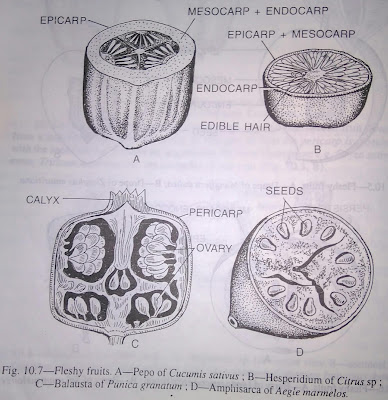Indehiscent fruits do not burst or split open at maturity, the seeds are liberated only by the decaying or by accidental destruction of the pericarp. This type of fruit may be again (1) dry and (2) fleshy.
1. Dry lndehiscent fruits-These may be of following types :
(a) Cypsella-It is dry, one-celled and one-seeded fruit which develops from an inferior bicarpellary ovary. Here the pericarp is free from the seed coat. Example-Helianthus annuus, Cosmos sp. and other members of the family Compositae.
(b) Caryopsis-It is a very small, one-celled, dry and one-seeded fruit developing from a superior monocarpellary ovary. In this type of fruit the pericarp is closely fused with the seed coat and is therefore inseparable. Fruits of Gramineae e.g. Oryza sativa, Zea mays, Triticum aestivum, etc. are examples of this type.
(c) Achene-It is a small, dry one-celled and one-seeded fruit which develops from a Superior or inferior monocarpellary ovary. In this type, the pericarp is very thin and free from the seed coat. Examples-species of Naravelia, Clematis (Ranunculaceae), Boerhaavia repens, Mirabilis jalapa (Nyctaginaceae) etc.
(d) Utricle-It is a dry, one-celled, one or few-seeded fruit developing from a superior monocarpellary ovary. The fruit is provided with a thin membranous loose pericarp which is not attached to the seed coat. Examples-Basella sp., Chenopodium sp. (Chenopodiaceae) etc.
(e) Nut or Glans-It is a dry, one-celled and one-seeded fruit which develops from a superior, bi- or polycarpellary ovary having a hard and woody pericarp. Sometimes, the fruit is enclosed by cupular persistent bract. Examples-Anacardium occidentale, species of Quercus, Trapa, Fagus, Castanea, etc.
2. Fleshy fruits :
(a) Drupe-It is a fleshy, one or more-chambered, one or more seeded fruit developing from a superior monocarpellary or polycarpellary ovary. Here the pericarp is differentiated into epicarp, mesocarp and endocarp. The epicarp forms the skin of the fruit, the mesocarp usually forms the fibrous and juicy pulp, and endocarp forms the hard and stony inner layer. Example-Prunus domestica, Prunus armeniaca (Rosaceae), Mangifera indica (Anacardiaceae), Zizyphus mauritiana (Rhamnaceae) etc. In Cocos nucifera (coconut), Areca catechu (betel-nut, Palmae) the mesocarp is dry and fibrous-hence coconut, betel-nut etc. are called fibrous drupe. Borassus flabellifer (palmyra palm, Palmae) is the example of more than one-seeded drupe, but in this case each seed is provided with a separate endocarp round it.
(b) Berry or Bacca-It is usually a many-seeded fleshy fruit which develops from monocarpellary or polycarpellary superior or inferior ovary. The seeds after separation from the placenta lie embedded freely in the massive pulp formed from the mesocarp and the endocarp of the pericarp, the epicarp remains as the skin of the fruit. Examples-Musa paradisiaca (Banana, Musaceae), Lycopersicon esculentum (tomato), Solanum melongena (Brinjal) etc. of Solanaceae. Phoenix sylvestris (date palm, Palmae) is the example of one-seeded berry, here the endocarp is thin and papery. Sometimes the pericarp may not be differentiated into epi-, meso and endocarps.
The berry may be modified into the following types :
(i) Balausta-It is an inferior, many-celled and many-seeded fruit with leathery or tough pericarp ; the carpels are placed in two rows, one above the other with thin yellow papery partition walls. The seeds have succulent seed coat (testa) which forms the edible part. Example-Punica granatum (Pomegranate, Rosaceae).
(ii) Amphisarca-It is a superior, many-celled, many-seeded fruit with woody pericarp. The placenta and the inner layer of the pericarp form the pulpy edible part. The seeds are provided .with mucilaginous seed-coat (testa). Example-Aegle marmelos (wood-apple), Feronia limoma (wood-apple, katbel) of the family Rutaceae.
(c) Hesperidium-It is a many-celled fleshy fruit which develops from a polycarpellary superior ovary with axile placentation. Here the epicarp and mesocarp are fused together forming the skin (rind) of the fruit, the endocarp remains thin papery forming the outer covering of compartments ; the edible part is the inner juicy succulent hairs of the endocarp. Examples-Citrus aurantium (lemon, Rutaceae).
(d) Pepo-It is also a fleshy, many-seeded fruit which develops from the inferior, one-celled or falsely 3-celled polycarpellary ovary with parietal placentation. Here the epicarp is leathery or more or less hard, the seeds remain attached to the placenta not like typical berry but loosely embedded in the pulp. Examples-fruits of Lagenaria siceraria, Cucurbita sp. etc. (Cucurbitaceae).
(e) Pome-This is a two to many-celled inferior, fleshy syncarpous fruit. Here the thalamus becomes enlarged, fleshy and succulent forming the edible part, it covers the ovaiy which is more or less bony containing seeds-this type of false fruit is known as pome. e.g. ;Malus sylvestris (apple, Rosaceae).





Comments
Post a Comment